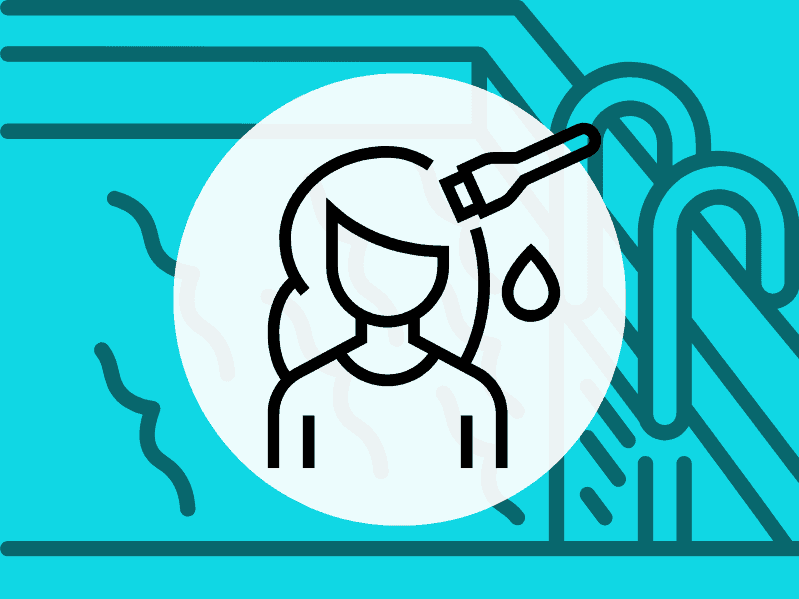When it comes to swimming, there are few things more enjoyable than taking a dip in the pool on a hot summer day.
However, if you have recently dyed your hair, you may be wondering if the chlorine in the pool will cause your hair color to fade or even completely wash out.
In this article, we’ll explore the factors that influence dye fade-out and provide some tips for prolonging your color’s poolside staying power!
Does Hair Dye Come Out In The Pool?
One of the main factors that can determine whether or not your hair dye will come out in the pool is the type of hair dye you have used.
Permanent hair dyes are designed to last for several weeks or even months, and are less likely to fade or wash out in the pool. Semi-permanent hair dyes, on the other hand, are designed to gradually fade over time, and are more susceptible to fading or washing out in the pool.
If you have recently dyed your hair and have not yet washed it, the excess dye may be more likely to come out in the pool.
Therefore, it is best advised to wait at least a week after dying your hair before going for a swim.

Other factors that influence how quickly hair dye comes out in the pool include:
- How often you swim – More frequent swimming means more exposure to chlorine, leading to faster fading. Going in the pool just once after dyeing is less likely to cause issues than swimming daily.
- Water temperature – Warmer water temperatures may cause dye to fade slightly faster than cooler water. Hot tubs are particularly hard on recently applied dye.
- Hair texture – Thicker, coarser hair tends to hold dye better than fine, porous hair which can absorb chlorinated water more easily.
- UV exposure – Sunlight contains UV rays that also contribute to dye breakdown over time. Swimming during sunny days may cause slightly faster fading.
Hair Dye And Pool Water Interaction
Now let’s go ahead and explore the interaction between hair dye and pool water to help you understand what happens when the two come into contact.
Chemistry Of Hair Dye
Hair dye is made up of chemicals that penetrate the hair shaft to change its color.
These chemicals can be divided into two categories: oxidative and non-oxidative.
Oxidative dyes, which are the most common type, work by reacting with the hair’s natural melanin to create a new color.
Non-oxidative dyes, on the other hand, simply coat the hair shaft with color.
Effects Of Chlorinated Water On Dyed Hair
Chlorine is a common disinfectant used in swimming pools to kill bacteria and other harmful microorganisms. However, it can also have a negative effect on dyed hair.
When hair dye comes into contact with chlorinated water, the chlorine can strip the color from the hair, making it fade or even turn green.
This is because chlorine can break down the chemical bonds that hold the dye molecules in place.
To minimize the damage to your dyed hair, it’s important to rinse your hair thoroughly with fresh water before and after swimming.
You can also protect your hair by wearing a swim cap or applying a leave-in conditioner before getting in the pool.
Influence Of Saltwater On Hair Color
Saltwater, which is found in oceans and some swimming pools, can also affect the color of dyed hair.
Like chlorine, salt can break down the chemical bonds in hair dye, causing it to fade or change color. However, the effects of saltwater on hair dye are generally less severe than those of chlorinated water.
To protect your dyed hair from saltwater, you can rinse it with fresh water after swimming and apply a leave-in conditioner to help lock in the color.
How To Prevent Hair Dye From Running In The Pool
Wait At Least 7 Days After Dyeing Hair
Most hair professionals recommend waiting at least one week after dyeing your hair before swimming and getting your hair wet in chlorinated water.
This initial waiting period gives the dye adequate time to fully set into the hair fibers.
For permanent dyes, waiting 7 full days allows the color to fully develop and cure before confronting chlorine’s bleaching effects.
This significantly reduces the chances of any color loss occurring in the early days of swimming.
Swim Caps and Their Role
Wearing a swim cap is one of the most effective ways to prevent hair dye from fading in the pool.
Swim caps create a barrier between your hair and the water, preventing the chlorine and other chemicals from stripping your hair of its color.
There are different types of swim caps available, so choose one that fits comfortably and securely.
Pre-Swim Hair Protection Techniques
Before you go for a swim, there are some things you can do to protect your hair from the damaging effects of chlorine and other chemicals in the pool.
One of the most effective techniques is to apply a leave-in conditioner, deep conditioning mask or protective oil to your hair.
This will create a barrier between your hair and the water, preventing the chemicals from penetrating the hair shaft.
Another technique is to apply coconut oil to your hair before you go for a swim.
Coconut oil is a natural conditioner that can help to protect your hair from damage. Simply apply a small amount of coconut oil to your hair, focusing on the ends, and then put on your swim cap.
Post-Swim Hair Care
After you have finished swimming, it is important to take care of your hair to prevent the color from fading.
Rinse your hair thoroughly with fresh water to remove any chlorine or other chemicals.
Then, apply a conditioner to your hair to help restore moisture and prevent damage.
These products are specifically designed to help preserve hair color and prevent fading.
Dealing With Discoloration And Dryness
If you frequently swim in a pool, you may have noticed that your hair color has changed or become dull. This is because hair dye can come out in the pool due to the chlorine and other chemicals present in the water.
Besides discoloration, chlorine exposure can also cause dryness and damage to your hair.
Tackling Green Hair from Chlorine Exposure
One of the most common issues caused by chlorine exposure is green hair. This is especially common for those with blonde or light-colored hair.
The green tint is caused by copper present in the pool water, which can bind to the proteins in your hair.
To tackle green hair, you can try using a clarifying shampoo or a hair mask that contains chelating agents.
Chelating agents bind to the copper in your hair and help to remove it. You can also try rinsing your hair with apple cider vinegar, which can help to neutralize the copper.
Combating Dryness and Preserving Natural Oils
Chlorine exposure can also cause your hair to become dry and brittle.
To combat dryness, it’s important to use a moisturizing shampoo and conditioner.
Look for products that contain natural oils, such as argan oil or coconut oil, which can help to nourish your hair.
You can also use a hair mask once a week to provide extra moisture and hydration.
Protecting Color-Treated Hair From The Sun
While chlorine is often blamed for stripping hair color, the sun can also have a significant impact on the vibrancy of your hair dye.
The Impact of UV Rays on Hair Dye
UV rays can cause hair color to fade and become dull over time. This is because the sun break down the chemical bonds in hair dye, causing it to lose its vibrancy.
This is especially true for red and blonde hair, which tend to fade faster than darker shades.
Sun Protection Strategies for Swimmers
If you want to protect your color-treated hair from the sun while swimming, there are a few strategies you can try:
- Wear a swim cap: A swim cap can help protect your hair from the sun’s rays while swimming. Look for a cap that is made from a UV-resistant material for added protection.
- Use a leave-in conditioner: Applying a leave-in conditioner before swimming can help protect your hair from the sun. Look for a conditioner that contains UV filters for added protection.
- Rinse your hair after swimming: After swimming, rinse your hair with cool water to remove any chlorine or saltwater. This can help prevent damage and fading.
- Use a hair sunscreen: Just like you protect your skin from the sun, you can also protect your hair with a hair sunscreen. Look for a product that is specifically designed for use in the sun.
Other Questions You May Have
Can You Swim Immediately After Dyeing Your Hair?
It is not recommended to swim immediately after dyeing your hair. Your hair needs time to absorb the color and the chemicals from the dye. Swimming in a pool can cause the color to fade or even change, especially if the pool has a high chlorine level.
To be safe, it is best to wait at least 7 days after dyeing your hair before swimming in a pool.
Will pool chemicals damage my dyed hair over time?
Prolonged exposure to chlorinated pool water and harsh pool chemicals can potentially cause serious damage to dyed hair. Chlorine acts as a drying agent and can strip dyed hair of its protective pigment layer and moisture over time.
Blond hair tends to be more vulnerable since it requires lightening with bleaching agents.
It’s best to limit pool time if possible for the first week or so after a dye job to allow the cuticle to strengthen. Rinsing chlorinated water from hair promptly also helps reduce chlorine damage.
Can I still swim with dyed hair?
Swimming is still possible for those with dyed hair as long as some protective measures are taken. The best way is to wear a tightly secured swimming cap to create a physical barrier between the hair and chlorinated water.
You can also try rinsing hair with cool water and applying hair products such as moisturizing oil or a conditioning mask before swimming.
It’s also a good idea to shampoo hair promptly after swimming and avoid chlorinated pools for a few days following a dye job until the color has fully set in the hair fibers.
Will my hair color fade faster in a swimming pool?
Swimming pool water can cause hair color to fade more quickly than it otherwise would due to the presence of chlorine and other harsh chemicals. How much faster depends on factors like hair type, how often one swims, the type of dye used (permanent or semi-permanent), and whether protective measures are taken.
Chlorine strips hair of its protective cuticle layer over time, allowing artificial color molecules to fade or wash out more readily.
Taking steps to limit direct contact with pool water can help hair color last longer when swimming.
What are the effects of lake water on hair that has been dyed?
Lake water can also have a damaging effect on hair that has been dyed. The minerals and chemicals in lake water can cause the color to fade or change, and can also dry out the hair.
That said, swimming in a lake is still the best choice as it generally clean water that contains the least chlorine and salt.

